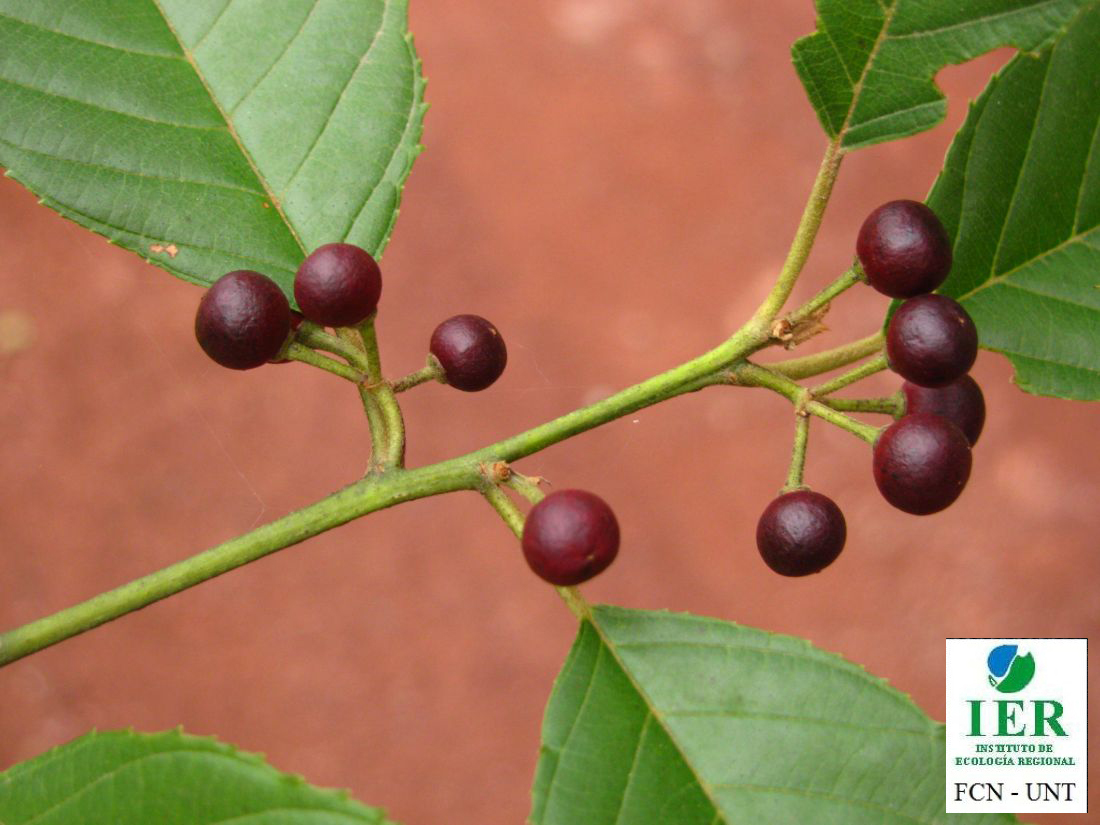Descripcion
Arbustos o arbolitos de 2-8 m de alto, inermes; ramas jóvenes generalmente pubescentes con tricomas broncíneos de 0,2-0,5 mm de largo, luego glabras. Hojas persistentes; pecíolo de 0,5-1,3(-2,1) cm de largo, pubescente; láminas elípticas u obovado-elípticas, de (4-)6-11(-19,5) × 3,2-3,8(-5,2) cm, base redondeada o raramente cuneada, algo asimétrica, ápice acuminado, el margen aserrado o crenado, glandular, subcoriáceas; estípulas subuladas de (2-)3 mm de largo, caducas. Inflorescencias en cimas axilares generalmente 10-14-floras; pedúnculos de (0-)2-10(-17) mm de largo. Flores 5-meras, perfectas, blanquecino-liláceas a amarillentas; pedicelos de 2-4(-7) mm de largo; tubo urceolado, de 2 mm de largo, pubescente; dientes del cáliz de 1,5 mm de largo, cara dorsal pubescente; pétalos 2-lobados, de 0,7-1 mm de largo, glabros; filamento estaminal con base ensanchada de 0,9 mm de largo, anteras de 0,8 mm de largo; ovario 1 mm de largo; estilo breve y estigma casi sésil. Fruto una drupa casi esférica, de 4-7 mm de diámetro, rojiza o purpúreo-oscura, glabra. Semillas 3, de 6 mm de largo, claras, la cara externa convexa y la interna angular; pedicelos fructíferos de 5-6(-8) mm de largo.
Distribucion y Habitat
Variedad que se distribuye en Costa Rica, Panamá, Colombia, Venezuela, Perú, Bolivia, Paraguay, Brasil y norte de la Argentina, donde crece en selvas. Variedad citada para la provincia de Tucumán por Zuloaga et al. (2019), pero no se han podido estudiar ejemplares provenientes para dicha provincia.
Sinónimos
Rhamnus sphaerosperma Sw. var. pubescens
-
Rhamnus polymorpha (Reissek) Weberb. Nat. Pflanzenfam. 3(5): 410. 1895 Nom. illeg. hom., non Turczaninow 1842.
Rhamnus sectipetala Mart. ex Reissek, nom. nud. : .
Frangula polymorpha Reissek var. pubescens Reissek var. pubescens Reissek Fl. Bras. 11(1): 91. 1861
Frangula polymorpha Reissek Fl. Bras. 11(1): 91. 1861
Frangula polymorpha Reissek var. latifolia Chodat var. latifolia Chodat & Hassl. Bull. Herb. Boissier, sér. 2 3: 542. 1903
Ceanothus pubescens Ruiz & Pav. Fl. Peruv. 3: 6, tab. 228, fig. b. 1802
Frangula boliviana (Rusby) Grubov Trudy Bot. Inst. Akad. Nauk S.S.S.R., sér. 1, Fl. Sist. Vyssh. Rast. 8: 275. 1949
Frangula chrysophylla Reissek Fl. bras. 11(1): 91. 1861
Frangula citrifolia (Rusby) Grubov Trudy Bot. Inst. Akad. Nauk S.S.S.R., sér. 1, Fl. Sist. Vyssh. Rast. 8: 276. 1949
Frangula nervosa Grubov Bot. Mater. Otd. Sporov. Rast. Bot. Inst. Akad. Nauk SSSR 12: 124. 1950
Frangula peruviana Grubov Not. Syst. URSS 12: 124. 1950
Frangula polymorpha Reissek var. tomentosa Reissek var. tomentosa Reissek : .
Frangula pubescens (Ruiz & Pav.) Grubov Acta Inst. Bot. Acad. Sci. URSS, sér. 1 8: 273. 1949
Rhamnus boliviana Rusby Mem. Torrey Bot. Club 3(3): 15. 1893
Rhamnus citrifolia Rusby Bull. New York Bot. Gard. 4: 340. 1907
Rhamnus chrysophylla (Reissek) Weberb. Nat. Pflanzenfam. 3(5): 410. 1895
Rhamnus jelskii Szyszyl. : .
Rhamnus polymorpha (Reissek) Weberb. var. glabra (Reissek) Dusén var. glabra (Reissek) Dusén Arq. Mus. Nac. Rio de Janeiro 13: 53. 1903 Nom. illeg. superfl.
Rhamnus pubescens (Ruiz & Pav.) Triana & Planch. non Poir. Ann. Sci. Nat. Bot., sér. 5 16: 379. 1872 Nom. illeg. hom., non Poir. 1798.
Rhamnus pubescens (Ruiz & Pav.) Triana & Planch. non Poir. var. chrysophylla (Reissek) Kuntze var. chrysophylla (Reissek) Kuntze Revis. Gen. Pl. 1: 120. 1891
Rhamnus pubescens (Ruiz & Pav.) Triana & Planch. non Poir. var. glabrescens Kuntze var. glabrescens Kuntze : .
Rhamnus pubescens (Ruiz & Pav.) Triana & Planch. non Poir. var. grandifolia Perkins var. grandifolia Perkins : .
Bibliografía
Ejemplares de referencia
| Colector | N° Colect. | Especie | Departamento | Provincia | Imagen |
|---|---|---|---|---|---|
|
|
2420 | Caaguazú |
.thumb.jpg)
|
||
|
|
1891 | - |
.thumb.jpg)
|
||
|
|
5820 | Alto Paraná |
.thumb.jpg)
|
||
|
|
1812 | Canindeyú |
.thumb.jpg)
|
||
|
|
2323 | Blumenau | Santa Catarina |
.thumb.jpg)
|
|
|
|
1251 | - |
.thumb.jpg)
|
||
|
|
-1 | 29 | Rio Grande do Sul |
.thumb.jpg)
|
|
|
|
31039 | Rio Grande do Sul |
.thumb.jpg)
|
||
|
|
22918 | Caaguazú |
.thumb.jpg)
|
||
|
|
31417 | Alto Paraná |
.thumb.jpg)
|
Nombre Vulgar y Usos
Tipo y Observaciones
Material Tipo: Basónimo: Frangula polymorpha var. pubescens Reissek
Observaciones: Nombre vernáculo. “Picantillo”.

